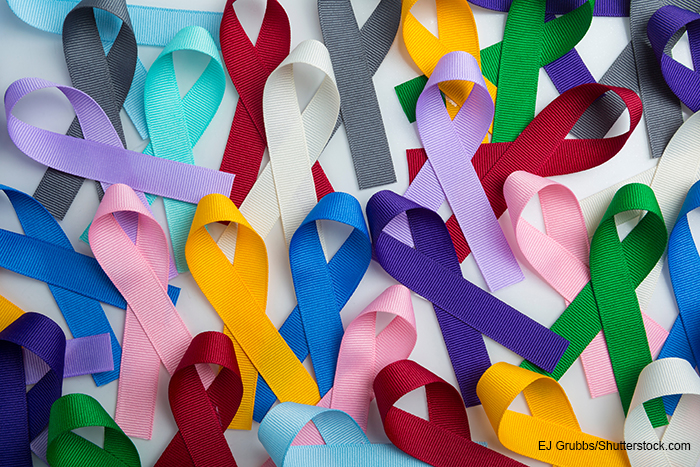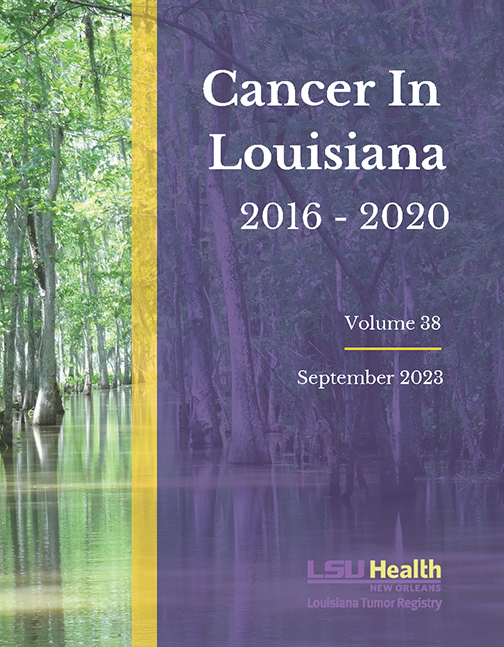LSU Health New Orleans Releases Latest Report on Cancer in Louisiana
September 18, 2023

“This year’s report is the first to include the period affected by the COVID-19 pandemic,” notes Xiao-Cheng Wu, MD, MPH, Professor and Director of the Louisiana Tumor Registry at LSU Health New Orleans School of Public Health. “While we assumed that we would see a decline in cancer incidence rates for diagnosis year 2020, we now have concrete evidence of the impact of the COVID-19 pandemic on cancer diagnoses. It is important to note that the decrease is likely due to the disruption in access to medical care rather than an actual decline in cancer incidence. It is essential to keep this in mind when interpreting the data from this report.”
“The pandemic severely tested our health care system, so cancer registry resources were often re-allocated,” says Lauren Maniscalco, MPH, Liaison at LSU Health New Orleans’ Louisiana Tumor Registry. “However, the hospital cancer registrars and Louisiana Tumor Registry (LTR) team continued to persevere and ensure that each and every cancer case is included. The LTR would like to express its sincere gratitude to all of the registrars in Louisiana who made this report possible despite the challenges of the pandemic.”The 7-Parish Industrial Corridor includes Ascension, East Baton Rouge, Iberville, St. Charles, St. James, St. John the Baptist, and West Baton Rouge parishes. The incidence rates for all cancers combined in white men and black men were significantly higher than the statewide rate. Rates for all cancers combined for white women and black women did not differ significantly from the Louisiana rates.

Louisiana’s incidence rates for all sites combined among children and adolescents (aged 0–19) were lower than U.S. rates for both boys and girls, but only the rate for girls was significantly lower. The most common cancers among children and adolescents in Louisiana are central nervous system tumors; this is also true for the U.S. However, if you exclude benign and borderline brain tumors, the most common cancer in Louisiana and the U.S. among children is leukemia.
The incidence rates of tobacco-related cancers are significantly higher in Louisiana than in the U.S. for all race and sex groups. Incidence rates for obesity-related cancers are significantly higher in Louisiana than in the U.S. for the four major race-sex groups, except for incidence for white women, which is not significantly different from the national rate. Incidence rates for HPV-related cancers are significantly higher in Louisiana than in the U.S. for the four major race-sex groups.An average of 9,345 deaths were attributed to cancer each year, 2016-2020. Only heart disease caused more deaths (an average of 11,420 per year in Louisiana) than cancer. For all Louisiana residents combined, cancer mortality was highest for cancer of the lung (26.4% of all cancer deaths), colorectum (9.2%), pancreas (7.3%), breast (7.2%), and liver/bile duct (5.5%). Statewide, each of the four major race/sex groups had a significantly higher death rate for all sites combined than its national counterpart. Lung and liver mortality rates were significantly higher in Louisiana than in the U.S. for all four race-sex groups.
In the 7-Parish Industrial Corridor, death rates for all cancers combined were significantly lower than those for Louisiana among white men, white women, and black women; black men in the Industrial Corridor experienced the same mortality rates as their counterparts statewide.In the 11-Parish Industrial Corridor, death rates for all cancers combined were significantly lower than those for Louisiana among all race/sex groups.
In Louisiana’s 0–19 age-group, the mortality rates were about the same in Louisiana and the U.S. for girls, but the rate for boys in Louisiana was significantly lower than their national counterparts.The mortality rates of tobacco-related cancers are significantly higher in Louisiana than in the U.S. for all race and sex groups. The mortality rates for obesity-related cancers are significantly higher in Louisiana than in the U.S. for the four major race-sex groups. The mortality rate for HPV-related cancers is significantly higher for black men, black women, and white women in Louisiana when compared to their national counterparts.
All incidence and death rates in this volume are average annual rates per 100,000 people for the five-year period, except for incidence rates for those 0-19 years of age, which are presented as average annual rates per 1,000,000 people for the five-year period. They are age adjusted to the U.S. 2000 standard and should not be compared with rates that are adjusted to the 1970 population.LSU Health New Orleans Louisiana Tumor Registry is a statewide population-based cancer registry authorized by law to collect data on all reportable cancer cases occurring among Louisiana residents. Population-based registries record all cases in a defined population (most frequently a geographical area such as a state or metropolitan area), to provide data for use by epidemiologists (scientists who find the causes of health outcomes and diseases in populations) and public health purposes. One of only 22 cancer registries in the country comprising the National Cancer Institute’s SEER Program, the Louisiana Tumor Registry at LSU Health New Orleans is considered to be one of the leading cancer registries in the nation.
______________________________________________________________________________________________________________ LSU Health Sciences Center New Orleans (LSU Health New Orleans) educates Louisiana's health care professionals. The state's health sciences university leader, LSU Health New Orleans includes a School of Medicine with campuses in Baton Rouge and Lafayette, the state's only School of Dentistry, Louisiana's only public School of Public Health, and Schools of Allied Health Professions, Nursing, and Graduate Studies. LSU Health New Orleans faculty take care of patients in public and private hospitals and clinics throughout the region. In the vanguard of biosciences research, the LSU Health New Orleans research enterprise generates jobs and enormous annual economic impact. LSU Health New Orleans faculty have made lifesaving discoveries and continue to work to prevent, advance treatment or cure disease. To learn more, visit http://www.lsuhsc.edu, http://www.twitter.com/LSUHealthNO, or http://www.facebook.com/LSUHSC.
